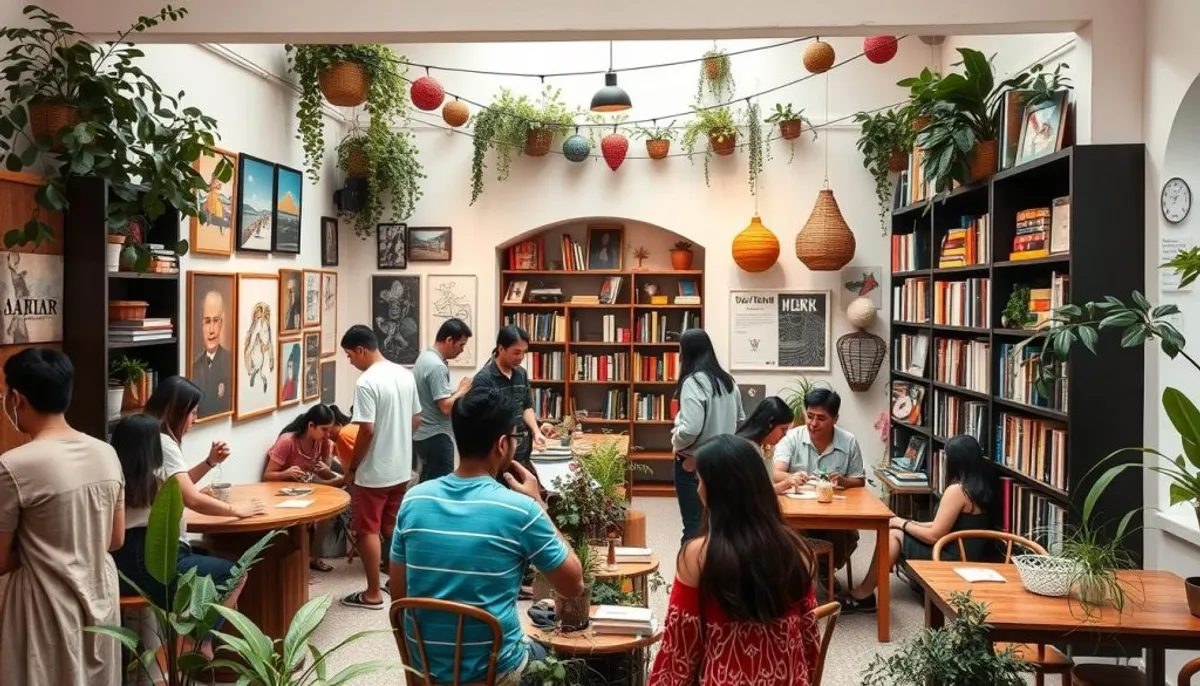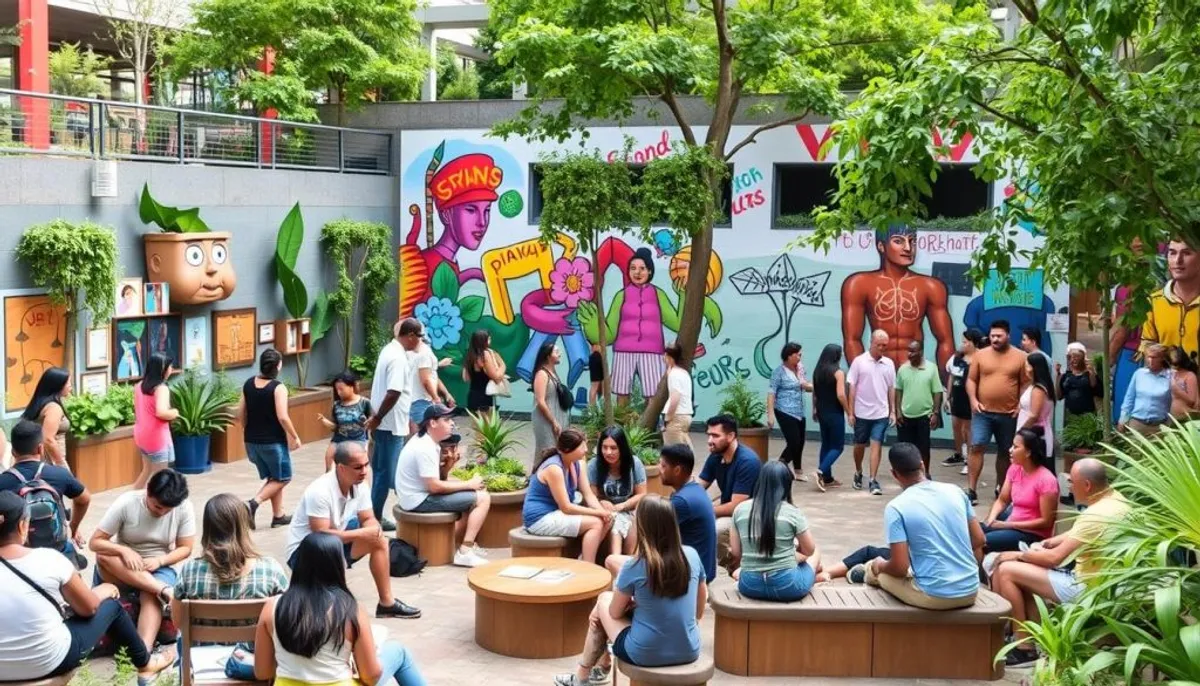A third cultural place transcends traditional boundaries between public and private. These hybrid spaces are designed to encourage creativity and social innovation. They create an environment conducive to informal exchanges and the innovation of ideas.

Imagine a place where one can work, learn, and share their passions. This is the concept of a third cultural place. These versatile spaces promote collaboration and stimulate collective creativity.
Third cultural places are essential for local development. They energize territories by offering opportunities for exchange and innovation. Tailored to the specific needs of each community, they play a key role.
In conclusion, a third cultural place is an open space that fosters social interactions and creativity. It provides fertile ground for innovation and strengthens the local social fabric.
The origin and evolution of the third place concept
The concept of the third place has undergone a remarkable transformation since its first appearance. It has profoundly changed our perception of social spaces and their influence on our communities, thus fostering entrepreneurial creativity.
Ray Oldenburg's theory and the "third place"
Ray Oldenburg, an American sociologist, proposed the concept of the "third place" in 1989. He described these places as distinct from home and the workplace. They are characterized by their neutrality, ease of access, and friendly atmosphere. Oldenburg emphasized their importance in community life.

The emergence of third places in France
In France, the evolution of third places has been significant. In 2021, France Tiers-Lieux counted 2,500 structures. This number reached over 3,700 in 2023. These spaces encourage cooperation, innovation, and collective projects. They act as catalysts for activities with a positive impact.
From urban concept to rural revitalization
Third places first emerged in urban areas. However, they have expanded to rural territories. In 2021, they were predominantly located outside major urban centers. They play an essential role in territorial revitalization. These spaces offer opportunities for innovation and development, reducing disparities between urban and rural areas.
| Year | Number of third places in France | Main Location |
|---|---|---|
| 2021 | 2,500 | Predominantly outside major cities |
| 2023 | 3,700+ | Balanced urban/rural distribution |
The fundamental characteristics of a third place
Third places are characterized by their flexibility and capacity for innovation. They offer a new perspective on social and professional life. These spaces respond to the changing needs of our society.
A hybrid space between public and private
The hybrid space of third places abolishes traditional distinctions. They exist between public and private, fostering informal exchanges and creativity. This hybridity encourages social mixing and innovation.
The pooling of resources and skills
Pooling is essential in third places. It allows for the sharing of premises, tools, and knowledge. This approach optimizes resource use and stimulates innovation. Users have access to a variety of equipment and expertise, enriching their projects.
The importance of community and collectivity
The community is central in third places. Users play an active role in the life of the space. This collective participation creates a sense of belonging and encourages collaboration among diverse individuals.

| Characteristic | Impact |
|---|---|
| Hybrid space | Fosters social mixing and creativity |
| Pooling | Optimizes resources and stimulates innovation |
| Community | Strengthens the sense of belonging and collaboration |
These characteristics make third places unique spaces that foster innovation and social experimentation. They represent a new vision of collective life, based on flexibility and collaboration.
What is a cultural third place
A cultural third place is a dynamic space dedicated to artistic life and territorial animation. These unique cultural spaces play a crucial role in revitalizing urban and rural areas. They offer a platform for creative expression and community engagement.
Cultural third places stand out for their ability to bring together diverse audiences. They include residents, entrepreneurs, artists, and researchers. These places serve as a bridge between public and associative cultural actors. They also revitalize cultural wastelands, thus promoting community engagement.
- Art exhibitions
- Concerts and live performances
- Creative workshops
- Co-working spaces
- Social innovation laboratories
The importance of cultural third places is reflected in the figures:
| Statistic | Data |
|---|---|
| Number of third places in France (2023) | 3500 |
| Direct jobs created | 24,700 |
| State investment | €179.1 million |
| Third places in rural areas | 34% |
These figures highlight the significant impact of cultural third places on the local economy. They also demonstrate the growing commitment of the State to support these innovative spaces.
The various activities and services offered in a cultural third place
Cultural third places offer a variety of activities and services. They respond to the needs of the local community. These spaces promote creation, learning, and sharing.
Exhibition and artistic creation spaces
Exhibitions are at the heart of cultural third places. 60% of these spaces focus on collaboration and artistic innovation. They provide opportunities for local and emerging artists to showcase their work.
These places encourage collaborative creation. They provide equipped artistic workshops.
Cultural events and live performances
Cultural third places enliven local life by organizing various shows. 30% of them are equipped to host professional events. These versatile spaces host concerts, theater plays, and artistic performances.
By providing a stage for local and national talents, they enrich cultural life, particularly looking towards cinema in 2025.
Participatory and collaborative workshops
Collaborative creation is encouraged through participatory workshops. 25% of third places offer on-site training. These artistic workshops allow participants to exchange skills.
Participants learn new techniques. They work together on creative projects.
| Type of activity | Percentage of third places |
|---|---|
| Co-working spaces | 80% |
| Fablabs | 45% |
| Meeting rooms | 55% |
| Professional events | 30% |
| Training | 25% |
Conclusion
Cultural third places play a crucial role in territorial impact and social innovation in France. They provide flexible spaces that meet the diverse needs of freelancers, businesses, and startups. These places offer advantages such as cost reduction and stimulation of creativity.
The future of cultural third places is promising, with notable expansion in rural areas. 34% of them are now located in these zones. This presence meets a real need, as 22 million French people reside in rural areas. The Culture and Rurality plan, with €98 million over three years, underscores the importance of these initiatives.
The diversity of activities offered is impressive: 58% of third places provide cultural and artistic activities. These activities range from dissemination to creation, including hosting artists in residence. This versatility makes cultural third places catalysts for local dynamism. They promote the emergence of a collaborative and innovative economy.
RelatedRelated articles


